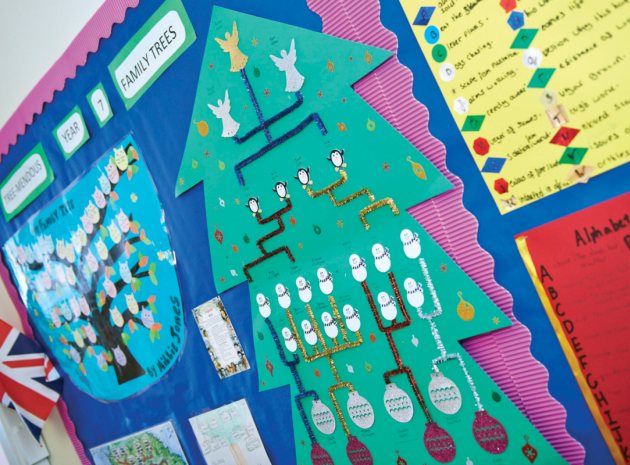Take a tip from the primary sector, and turn your classroom walls into interactive learning resources…
Most of us let out a sigh when asked about wall displays. We know that pupil behaviour is worse in drab classrooms and we are aware, too, that putting up a student’s work shows him or her it’s valued. But for many of us ‘wall displays’ are only really organised before an open day or for Ofsted, and we may not find time to change them for the rest of the year. We put up key words to help pupils understand specialist vocabulary (and remind them to use it), or posters and newspaper articles to show how the concepts they are learning can be applied to real life. We might even use maps or timelines help to give a geographical or historical context to topics. But no matter how good these look at the start of the term, they end up tired, forgotten… and barely noticed by learners. The best displays, then, must be ones we can actually make use of during lessons and easily change to keep them relevant; a practical resource to benefit our teaching and learning. In many cases pupils can be involved in creating them – and research suggests that in these instances they are much more likely to refer back to them. Here are five easy and interactive ideas to get you started…
1. Hang-ups
Make a versatile display by running some string or washing line between two ‘poles’ of cardboard tube on a plain background. Anything relevant to a lesson can be hung from the line, such as pupil work or key words, and using pegs to makes easy to change the display as often as you like. It can be used at the start of a lesson to demonstrate events or processes in a sequence (such as the order of operations in maths) and left hanging to support the lesson’s work, or it could contain important background information that pupils use during the tasks.
2. A graph for all seasons
Whatever our subject, there are two graphs that we probably all use: a bar chart and a Venn diagram. For the latter, use plastic hoops to make two overlapping circles (hand drawn can also work well). Temporary headings are given to each circle during the lesson, with pupils using sticky notes or flashcards to add their ideas when comparing two concepts – for example, crime and deviance in sociology. The bar chart just needs two unlabelled axes (again, use temporary labels), with space for around five categories and enough laminated tokens for everyone in the class. Each pupil is given a token and asked to blu-tack up his or her vote – these can be used to prompt a discussion, check learning or canvas opinion. You can send pupils up to the wall individually or in small groups and learners may appreciate the freedom to change their answer as the lesson goes on.
3. Wonderwall
Not all interactive displays involve the pupils physically working with them. A Wonderwall is a visual display containing elements that are relevant to either a topic (e.g. the nervous system) or whole subject. By using a mix of bold images, big words in appropriate fonts, questions, quotations and newspaper headlines, you can create a display that pupils can use as a stimulus. It can help them to link together themes, find the ‘big picture’, generate questions or prompt answers. Ask pupils to bring in their own images to add to the Wall and they may just surprise you with their interpretations.
4. The Slow Build
Take a simple image or scene appropriate to the topic to create a ‘base’ display that pupils add to over a series of lessons by writing on pre-prepared card cut into relevant shapes. These contributions could involve things they have learned or questions they have generated (individually or in groups). For example, teaching the industrial revolution in history you could start with a factory scene and have pupils adding top hats – or in RE, a study of Buddhism could begin with a large Buddhist symbol, to which pupils fix writing in lotus shapes.
5. iWall
As a practical space, we sometimes need our displays to contain instructions, reminders or extension activities, and the Learning Tablet is a way of organising this information in a format with which many pupils will be familiar. Using grey backing with a black border it is easy to mimic the front of an iPad, and by stapling up clear plastic wallets (9-16 depending on space) you can create ‘apps’ holding worksheets or displaying key information.
About the author
Philippa Seago has ten years’ experience of teaching psychology and re. currently, she is teacher in charge of psychology at an outstanding community school in littleover, derby. she is also a blogger and writer.











Take a tip from the primary sector, and turn your classroom walls into interactive learning resources…